StayFill Review
Many of you are familiar with the concept of filling your automobile tires with nitrogen, rather than plain old air. Why do that? Isn’t air already 78% nitrogen? Indeed it is. However, a pure nitrogen fill is argued to be superior for a couple reasons.
First, if done properly and filled from a dry tank, you remove all humidity from your tire. When you have humid air, the water vapor expands and contracts with ambient temperature change – which can lend to more pressure change in your tire. Also, moisture simply tends to cause more corrosion to your wheels and expensive tire pressure monitoring systems.
The second reason to use nitrogen is due to the molecule size. Sorry guys, but in this case – bigger is better. All rubber tires are somewhat porous, meaning they aren’t truly solid. There are very small holes, or pores, through which gas can escape. If you have a larger molecule of gas, it cannot escape as easily. In terms of molecule size and how fast the gas will leak, CO2 is the worst, air is in the middle, and pure nitrogen is best.
So I can lose less pressure over time, protect my wheels from corrosion, and have less pressure change from temperature change. Sounds great! Where do I sign up? Nowadays, even most smaller garage-shop mechanics have a nitrogen tank, so it’s fairly easy to find (although they will charge you for it).
Nitrogen and Bicycles
What does this have to do with triathlon and bikes? Well, basic physics don’t change between automobiles and bicycles, so you get the same benefits on your bike. The only hurdle is cost and hassle. Not many of us are willing to buy and maintain a nitrogen tank in our garage. So what’s a triathlete to do? Buy some StayFill.
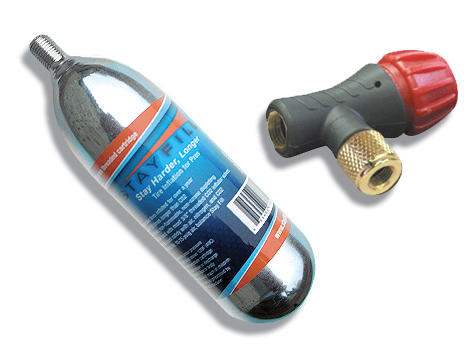
What is StayFill? According to their P.R. man, Prescott Stone, it is a proprietary gas blend that will keep your tires inflated for over a year. While they don’t list the exact ingredients, they do tell us that it is non-toxic, non-flammable, and non-ozone depleting. Nitrogen fits all of those bills, so my armchair guess is that these canisters contain mostly nitrogen. They even use the tagline that their product helps you… or perhaps – your tires – “Stay Harder, Longer”. If that doesn’t sell product, I don’t know what will.
Does it really work? After using Stayfill for several months, I can confirm that it does last longer than air. I installed it in to both mountain bikes and triathlon bikes… bikes with sealant, and without… here, there, and everywhere. StayFill works, Sam I Am – just don’t use it for green eggs and ham.
Specifically, my “control bike” for the experiment was one that lives permanently on an indoor trainer. About three months ago, I re-filled the tires with Stayfill. The tires are Vittoria’s Rubino Pro, along with standard weight butyl inner tubes. Both the front and rear tires went to 115psi. Today, they measured at 90psi. While this did drop some, it was certainly much slower than air would have. A few months of pump-free living was certainly nice – especially considering this bike is often used for the rushed after-work ride of “I-really-wish-I-had-two-hours-but-I-can-only-squeeze-in-fifty-minutes”. Every second spent pumping your tires is a second NOT spent riding.
While I'm not sure their pressure chart is entirely accurate, the product did last noticeably longer than air.
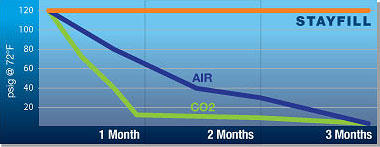
Tubeless, Latex, and Your Father’s Garage
They real benefit to StayFill, if you ask me, is for users of latex inner tubes. These are now all the rage due to their superior rolling qualities and light weight. The downside to latex, however, is that it is much more porous than a synthetic butyl inner tube (the standard ol’ tubes we’re used to). Latex loses air much faster. If you race with them, you must always pump up your tires race morning – if you do it the night before, you’ll likely start the race with less pressure than you bargained for. StayFill is an easy way to solve that problem.
There is another common scenario in which StayFill is a great solution: long-term storage. Raise your hand if your father’s garage includes a 1970’s Schwinn – with flat tires. Or, if you’re like me and have enough bikes to equip a small village, some of these bikes may sit dormant for months at a time. Maybe you ride that mountain bike in the winter, but it goes untouched during the summer. Perhaps you really just wanted to help stimulate the economy, and had to have that second set of race wheels for different wind conditions. When wheels and bikes sit for long periods of time, the tires go flat. Sure, you can always just pump them back up, but there are some modern complications which dictate that you keep your tires inflated all the time.
First is the use of latex-based tire sealants, such as Stan’s, Vittoria Pit Stop, or CaffeLatex. These sealants are great and can help you avoid punctures, but they also dry out over time. Users of tubeless tires are very familiar with the effects of this – what is lovingly known as “Stan’s coral”. Yes, open up the inside of that tire, and you’re often left with dried residue, including stalactites of dried latex. This happens in inner tubes as well; you just can’t see it. If your tire goes completely flat for too long, you can literally clot an entire section with dried latex. There is no bypass surgery for this type of clot, so you must replace the inner tube or tire. If you’re riding an expensive high-end tubular tire, we can agree that frequent replacement is not an attractive proposition. Simply fill those tires up with StayFill to their maximum pressure before putting them away for the winter season, and you’re set.
Also, users of tubeless tires – whether for road or mountain – know that it behooves them to keep air in the tires. Depending on your wheel and tire choice, the bead seal can sometimes be less than perfect. The tires can leak down over time, and you can even lose your tubeless seal entirely if left completely flat. If you’re the type to go months without riding your mountain bike and fancy tubeless tires – fill them up with StayFill and give your wheels a spin every few weeks. If that sounds like too much hassle, you’re likely better off skipping tubeless altogether.
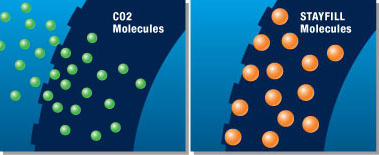
The Bad?
What are the downsides to StayFill? In my mind, the tangible downside is cost. StayFill is sold in two sizes: 25 gram and 115 gram. Yes, you read correctly. The 25 gram cartridge simply looks like a CO2 that you’re used to. The 115 gram cartridge, however, is simply huge in comparison. This is not something you’d want to keep in your jersey pocket or saddle bag. However, it does fill up three standard 700x23c road tires to about 115psi (8 bar). The “Starter Kit” with one 115g cartridge and an inflator valve runs about $30 USD. A replacement 4-pack of the big cartridges is $100. While this may seem expensive on the surface – remember the replacement cost of a tubular tire that has glued itself shut due to dried latex sealant. You’re buying longer tire life, and you’re buying more time for yourself (in the form of less time fiddling with your wheels and tires).
Of course there is also the issue that the TSA does not allow us to bring compressed gas containers on airplanes. So flying with StayFill is out. For your local races and home wheel storage, however, go to town. Perhaps if race organizers and bike shops begin to see the sales opportunity, they’ll start stocking StayFill in addition to CO2 cartridges at their expos (and charging a premium for it, if they’re smart).
The only other “downside” is actually a benefit, if you ask me. What am I talking about? In some cases, StayFill could actually outlast your tires or tubes. In fact, you could very easily puncture your tire the day after you inflate it with StayFill. While that would be unfortunate, it’s the gamble you take. This being the case, the product is likely not going to be popular with the collegiate triathlon crowd, who would much rather spend their limited cash on local race entries and beer. For the busy working athlete who spends full dollar on multiple Ironman races per year, however, the investment may be worthwhile.
It is also worth noting that in order to use StayFill, you must have a standalone air pressure gauge – that is, if you actually want to know how much pressure is inside the tire. I personally have the SKS digital gauge, which seems to work quite well. It measures in pounds per square inch (psi) or bar, and is easy to use. Analog gauges work fine too – just make sure you have some sort of pressure gauge handy.
The StayFill 115g cartridge:
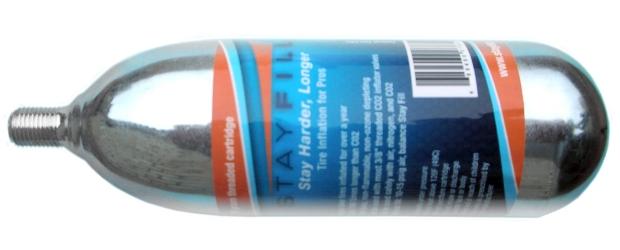
Learn more at www.stayfill.com/.




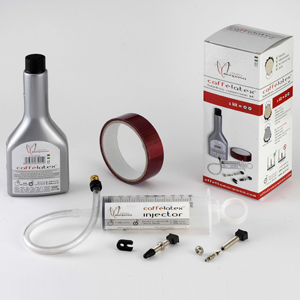
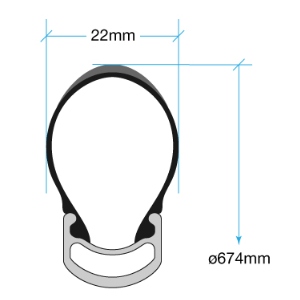

Start the discussion at forum.slowtwitch.com